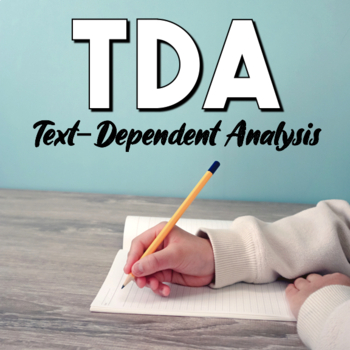Text Dependent Analysis — TDA Evidence Based Writing: Test Prep, Notes, & Rubric
Chomping at the Lit
5.6k Followers
Grade Levels
6th - 12th, Homeschool
Subjects
Resource Type
Standards
CCSSW.7.2
CCSSW.7.2a
CCSSW.7.2b
CCSSW.7.2c
CCSSW.7.2d
Formats Included
- Zip
Pages
6 & 12 Slides
Chomping at the Lit
5.6k Followers
What educators are saying
This resource is great! It helped me chunk my literary essay so the students understood the concepts better.
Description
Prepare your students to write a Text Dependent Analysis — TDA Evidence Based Writing! This lesson with cloze notes is great for test prep and includes a rubric that can be used for any TDA essay.
Included with this purchase:
1. Powerpoint presentation that explains:
- What is TDA (text-dependent analysis)
- What is NOT TDA
- How to write an effective TDA
- Introduction, Body, and Conclusion Paragraphs
- How to write a THESIS
- The 3 C's: Context, Content, Connection
- RACES acronym: Restate, Answer, Cite, Explain, and Summarize
2. Cloze Notes on TDA
- Student worksheet that correspond directly with the Powerpoint
- Graphic organizers with Sentence Starters and Transitional words and phrases
3. Writer's Checklist for TDA
4. TDA Essay Rubric which can be used with any TDA prompt
5. Editable copy of the notes for teachers to modify if needed
Total Pages
6 & 12 Slides
Answer Key
Does not apply
Teaching Duration
1 hour
Report this resource to TPT
Reported resources will be reviewed by our team. Report this resource to let us know if this resource violates TPT’s content guidelines.
Standards
to see state-specific standards (only available in the US).
CCSSW.7.2
Write informative/explanatory texts to examine a topic and convey ideas, concepts, and information through the selection, organization, and analysis of relevant content.
CCSSW.7.2a
Introduce a topic clearly, previewing what is to follow; organize ideas, concepts, and information, using strategies such as definition, classification, comparison/contrast, and cause/effect; include formatting (e.g., headings), graphics (e.g., charts, tables), and multimedia when useful to aiding comprehension.
CCSSW.7.2b
Develop the topic with relevant facts, definitions, concrete details, quotations, or other information and examples.
CCSSW.7.2c
Use appropriate transitions to create cohesion and clarify the relationships among ideas and concepts.
CCSSW.7.2d
Use precise language and domain-specific vocabulary to inform about or explain the topic.


